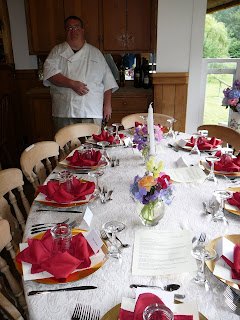Recently, I helped with a charity dinner on Lasqueti Island, held at the rustic heritage building pictured above. The goal was to raise funds for the island
community health centre. In all, $15,000 was raised for the centre! The event was organised by the talented and energetic Bonny Joy. Whose ability to encourage people to donate both time and items for the silent auction was impressive to say the least. It was a weekend of great people, good food and wine, and the knowledge that we were doing something to help make our corner of the world a better place.
This is the menu from the event, matching wines were served. All the produce came from Lasqueti farmers and the only thing that wasn't local was some lemon for the seafood and a few condiments.
The Lasqueti Last Resort Society Gala
August 31, 2011
Tasting plate of sustainable BC fish and shellfish
Local tuna poached in cold pressed canola oil, chili & preserved lemon
Cold smoked honey mussels, prawn and crab vinaigrette
With salsa & sourdough crostini
Salad of tender Lasqueti greens & flowers
Summer tomatoes & cucumbers
Herb & cider vinaigrette
Salish Sea smoked sea salt, Eden garlic & rosemary roasted Lasqueti lamb
Minted huckleberry & red onion relish, Moonstruck feta tsatsiki
Medley of Lasqueti vegetables with herb butter
Roasted baby potatoes
Le trou Lasqueti-
Blackberry wine and black pepper sorbet floating in Slivovitz sirop
A selection of exquisite homemade Lasqueti desserts
With Chantilly cream
Delicacies to end your feast-
Moonstruck cheeses, Beddis bleu & Karl’s Bigleaf Maple Sirop marinated white grapes
Wolf Island chocolates, seasonal fresh fruit & hazelnut biscotti
We started the weekend before by butchering three feral sheep. The lambs were split from nose to tail, boned out and rubbed with an aromatic mixture of rosemary, local garlic, juniper, smoked sea salt (provided by one of the local volunteers)and cracked black pepper. The boneless meat was then rolled and put in a very cold fridge to marinate for the week. On the day of the event the boneless lambs were wrapped in pork caul fat and slowly roasted. The caul had the effect of forming the meat into tight rolls that held their shape when sliced. Served with a minted huckleberry & balsamic relish and a jus that had been reduced for three days, the lamb was succulent and delicious.
Janine a local woman who had been Hospitality Director for Holland America, decorated the room and provided advice on how to run the service. It was a glittering, elegant display that made everyone who walked into the room stop and go..wow!
Despite being a long and arduous day it was helped by the able and good humoured assistance of several local women. Annie, Gail, the two Kathy's, and Wendy were amazing, helping to prep all the vegetables, seafood and fruit, prepare a beautiful salad topping, and serve the meal. I could not have had a better time: hand feeding lamb to my lovely assistants and making bad jokes made the day go remarkably smoothly. (not to mention the judicious application of some fine fermented grape juice)

I have always been well supported by the local community on Salt Spring, so when I was asked if I would help with this event it was a no brainer even if it was on another island. (Not to mention that my girlfriend was one of the ones doing the asking.) It has become important in these difficult times to know that when help is needed you can rely on your neighbours and community to come forward. The bond that has been made with these people is something I feel profoundly and it is part of what makes me happy to live where I do. As a chef from a different generation, I did an apprenticeship that was partially subsidized with Government (and indirectly taxpayer/community) support, and so to return the favour when asked is something I do gladly.
Photos by John Martin(thank you) with additional photos by Heather Cameron

























